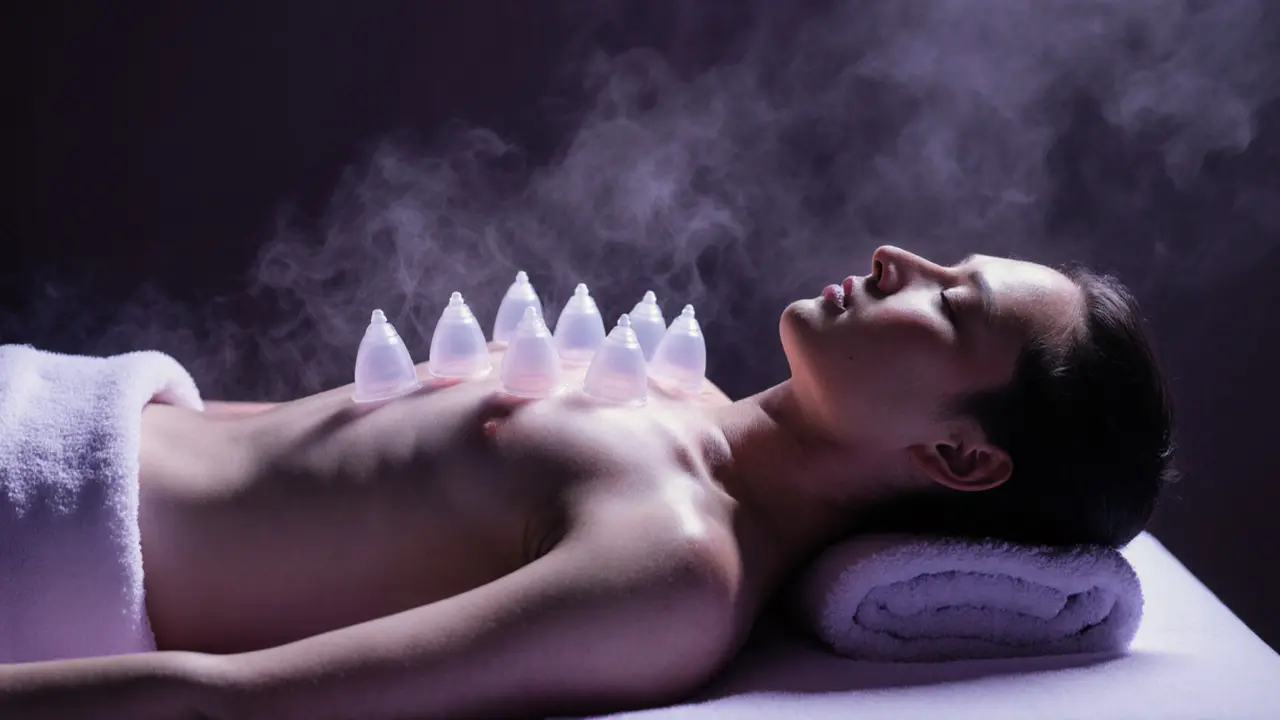How Do You Know Cupping Is Working? Signs It’s Actually Making a Difference
When you first try cupping therapy, it’s easy to wonder: Is this actually doing anything? You might see red circles on your skin, feel a strange tightness, or even feel nothing at all. That’s normal. Cupping doesn’t work like a painkiller you can instantly feel. Its effects are quieter, deeper, and often show up over hours or days-not minutes.
Many people come to cupping after years of dealing with muscle knots, chronic stiffness, or stress that won’t quit. They’ve tried massage, stretching, even acupuncture. Cupping feels different-it’s not about pressure, it’s about suction. So how do you know it’s working? This guide breaks down the real, observable signs that cupping is having an impact on your body, based on how it’s practiced today in clinics across Dubai and beyond.
Understanding the Basics of Cupping Therapy
Origins and History
Cupping has roots stretching back thousands of years. Ancient Egyptians, Greeks, and Chinese all used some form of suction therapy. In traditional Chinese medicine, it was believed to move stagnant Qi (energy) and blood, helping restore balance. In the Middle East, it was known as hijama-often combined with bloodletting. Today, modern cupping in places like Dubai focuses mostly on dry cupping: using silicone or glass cups to create gentle suction on the skin. It’s no longer tied to spiritual rituals but is grounded in what we now understand about fascia, circulation, and nervous system response.
Core Principles or Components
At its simplest, cupping creates negative pressure. The cup pulls the skin and underlying tissue upward, which increases blood flow to that area. This isn’t just about red marks-it’s about triggering your body’s natural healing response. The suction helps loosen tight fascia (the connective tissue surrounding muscles), reduces inflammation, and signals your nervous system to relax. Think of it like gently pulling apart stuck layers of paper-you’re not forcing them, you’re giving them space to separate naturally.
How It Differs from Related Practices
People often confuse cupping with massage or acupuncture. Here’s how they’re different:
| Practice | Key Feature | Primary Benefit |
|---|---|---|
| Cupping | Uses suction to lift tissue | Releases fascial adhesions, improves circulation |
| Massage | Applies pressure downward | Relaxes muscles, reduces tension |
| Acupuncture | Inserts fine needles into points | Regulates nervous system, balances energy flow |
Cupping doesn’t crush or knead-it lifts. That’s why it’s especially helpful for areas that feel tight but don’t respond to deep pressure. If massage feels like a fist, cupping feels like a soft vacuum.
Who Can Benefit from Cupping Therapy?
Most adults with muscle tension, athletes recovering from workouts, or people with chronic stress can benefit. It’s also popular among those with desk-related pain-tight shoulders from typing, stiff necks from looking at screens all day. People with arthritis or fibromyalgia often report reduced stiffness after sessions. But it’s not for everyone. If you have thin skin, bleeding disorders, or are pregnant, you should talk to a professional first.
Benefits of Cupping Therapy for the Body
Stress Reduction
When your body is under stress, your muscles stay tense-even when you’re not aware of it. Cupping helps break that cycle. The gentle pull on your skin sends signals to your brain that say, “You’re safe now.” This triggers your parasympathetic nervous system, the one responsible for rest and repair. Many clients say they feel lighter, calmer, even a little sleepy after a session. It’s not magic-it’s physiology.
Enhanced Mobility
One of the clearest signs cupping is working? You move better. Maybe you notice you can turn your head further without a twinge. Or your lower back feels less stiff when you bend over. That’s because cupping helps release fascial restrictions. Fascia can get sticky from injury, inactivity, or stress. Cupping gently peels those layers apart, letting your muscles glide again. You don’t need to feel pain to know it’s working-just freedom.
Emotional Well-Being
Physical tension and emotional stress are deeply linked. When your body is tight, your mind stays alert. When your body relaxes, your mind follows. Many people report feeling more emotionally balanced after cupping-not because it “fixes” anxiety, but because it reduces the physical burden that keeps stress alive. It’s like finally taking off a backpack you didn’t realize you were still carrying.
Practical Applications
Here’s what cupping can do in daily life:
| Benefit | Description | Impact |
|---|---|---|
| Reduced muscle soreness | Helps flush out metabolic waste after exercise | Faster recovery, less downtime |
| Improved sleep | Calms the nervous system | Deeper, more restful sleep |
| Less reliance on painkillers | Addresses root causes of tension | More natural pain management |
| Increased body awareness | Helps you notice where you hold tension | Better posture, mindful movement |
What to Expect When Engaging with Cupping Therapy
Setting or Context
Most cupping sessions happen in quiet, dimly lit rooms-think soft music, warm towels, and the faint smell of lavender. In Dubai, many spas combine cupping with aromatherapy or heat lamps to deepen relaxation. The environment matters. If you’re in a noisy clinic or rushed appointment, you won’t get the full benefit. A good session feels like a pause in your day, not another task to check off.
Key Processes or Steps
A typical session starts with a quick chat about your pain points. Then, the therapist applies oil to your skin so the cups glide smoothly. Cups are placed on areas like your back, shoulders, or legs. They stay for 5-15 minutes. Some therapists use moving cupping-gently sliding the cups along your muscles. You might feel a mild pulling sensation, but it shouldn’t hurt. After removal, you’ll likely see circular marks-these fade in a few days.
Customization Options
Cupping isn’t one-size-fits-all. Pressure can be adjusted-light for relaxation, firmer for athletes. Cup size matters too: small cups for the neck, larger ones for the back. Some people prefer silicone cups for home use; others like glass for deeper suction. If you’re sensitive, ask for shorter sessions or fewer cups. A good practitioner will tailor it to you.
Communication and Preparation
Before your session, drink water. Avoid heavy meals right before. Afterward, rest. Don’t jump into a cold shower or intense workout. Your body is processing the release. Tell your therapist if you feel dizzy, nauseous, or overly sore. These aren’t normal-and they’re fixable.

How to Know Cupping Is Working
Here’s the truth: you don’t need to feel a dramatic change after one session. But if you’re consistent, you’ll notice these signs:
- Your muscles feel looser-not just during the session, but hours later.
- Pain shifts-maybe your shoulder ache moves from sharp to dull, or spreads less.
- You sleep better-you fall asleep faster or wake up less often.
- You move more naturally-reaching for something doesn’t make you wince.
- The marks fade faster-after a few sessions, your circles turn lighter and disappear in 2-3 days instead of 7.
If none of these show up after 3-4 sessions, it might not be the right tool for you-or you need a different practitioner. Cupping isn’t a cure-all, but it’s powerful when it fits.
Safety and Ethical Considerations
Choosing Qualified Practitioners
In Dubai, look for therapists certified in integrative or traditional medicine. Ask if they’ve trained in anatomy and contraindications. Avoid places that push cupping as a “detox” miracle-it’s not. A trustworthy practitioner will explain what cupping can and can’t do.
Safety Practices
Here’s what to expect from a clean, professional session:
| Practice | Purpose | Example |
|---|---|---|
| Single-use cups | Prevent infection | Disposable silicone cups or sterilized glass |
| Sanitized skin | Reduce risk of irritation | Alcohol wipe before application |
| No cupping on open wounds | Avoid complications | Wait until cuts or rashes heal |
Setting Boundaries
You’re in control. If the suction feels too strong, say so. If you don’t want cups on your back, ask for your legs instead. A good therapist will respect your limits. This isn’t a performance-it’s your body’s healing.
Contraindications or Risks
Avoid cupping if you have:
- Bleeding disorders or are on blood thinners
- Skin conditions like eczema or psoriasis in the area
- Pregnancy (especially on the abdomen or lower back)
- Recent surgery or fractures
Always consult your doctor if you’re unsure.
Enhancing Your Experience with Cupping Therapy
Adding Complementary Practices
Cupping works even better with movement. Try gentle yoga, walking, or foam rolling after a session. Hydration helps flush out what’s released. Some people pair it with heat therapy-like a warm towel on the back-to deepen relaxation.
Collaborative or Solo Engagement
Cupping is usually done alone, but some couples enjoy it together as a shared wellness ritual. It’s not about the marks-it’s about the quiet time. If you’re doing it at home with a silicone cup, keep it simple: 5 minutes on your shoulders, 2 times a week.
Using Tools or Props
For home use, silicone cups are safest. Avoid cheap plastic ones-they crack or don’t seal well. Look for ones with a manual pump so you control the pressure. Don’t use them on your face or neck unless you’ve been trained.
Regular Engagement for Benefits
Like stretching or meditation, cupping builds up over time. One session might feel nice. Three sessions might ease your pain. Six sessions might change how you move. Aim for once every 1-2 weeks for 4-6 weeks, then taper off. Consistency beats intensity.
Finding Resources or Experts for Cupping Therapy
Researching Qualified Practitioners
In Dubai, check spas affiliated with physiotherapy clinics or integrative health centers. Look for reviews that mention safety, cleanliness, and personalized care-not just “felt amazing.” Ask if they have training in anatomy or medical cupping.
Online Guides and Communities
Reputable sources include the National Center for Complementary and Integrative Health (NCCIH) or physiotherapy associations. Avoid YouTube videos that show extreme cupping-those aren’t safe or standard practice.
Legal or Cultural Considerations
In the UAE, cupping is widely accepted and often offered in luxury spas. But if it’s combined with bloodletting (hijama), it’s regulated differently. Make sure you know what kind of cupping you’re getting.
Resources for Continued Learning
Books like Cupping Therapy: A Clinical Guide or courses from certified physiotherapy schools can help if you want to go deeper. But for most people, a few sessions with a skilled therapist is all you need.
FAQ: Common Questions About Cupping Therapy
What to expect from cupping therapy?
You’ll likely feel a mild pulling sensation, similar to a deep tissue massage but without pressure. Afterward, you may see circular marks-these are not bruises, just areas where blood has been drawn closer to the surface. They usually fade within a week. Most people feel relaxed, sometimes even sleepy. Don’t expect instant pain relief; the real benefits often build over several sessions.
What happens during a cupping session?
The therapist applies oil to your skin, places cups on targeted areas, and uses suction-either by heat or a manual pump. The cups stay on for 5 to 15 minutes. In some cases, they’re moved slowly across the skin. The session ends with cup removal and a gentle stretch or massage. You’ll be encouraged to drink water and rest afterward. No needles, no pain-just gentle suction.
How does cupping differ from massage?
Massage applies pressure to compress muscles, while cupping uses suction to lift them. This makes cupping ideal for areas that feel stiff but don’t respond to deep pressure. It targets fascia more directly and can reach deeper layers without causing discomfort. Think of massage as squeezing a sponge and cupping as pulling it open.
What is the method of cupping?
The most common method today is dry cupping. A cup is placed on the skin, and air is removed to create suction. This lifts the skin and underlying tissue, increasing blood flow and relaxing tight fascia. Silicone cups are often used with a hand pump for control. Some therapists use moving cupping, where the cup glides over oiled skin. Wet cupping (with bloodletting) is different and requires medical training.
Is cupping suitable for beginners?
Yes, absolutely. Many people start with light suction and just one or two cups on their back or shoulders. It’s gentle, non-invasive, and doesn’t require any prior experience. The key is to communicate with your therapist about your comfort level. Start slow-don’t rush into intense sessions. Most beginners find it relaxing and are surprised by how good it feels.
Conclusion: Why Cupping Therapy is Worth Exploring
A Path to Better Movement
Cupping isn’t about chasing quick fixes. It’s about giving your body the space to heal itself. If you’ve tried everything else and still feel tight, stiff, or stuck-cupping might be the missing piece. It doesn’t promise miracles, but it does offer a quiet, effective way to release what’s holding you back.
Try It Mindfully
Start with one session. Don’t go in with big expectations. Just notice how you feel afterward. Did you breathe deeper? Move easier? Sleep better? Those are the real signs it’s working.
Share Your Journey
Tried cupping? Share your experience in the comments-what did you notice? Did the marks fade faster than you expected? Follow this blog for more practical wellness tips from Dubai’s spa scene.
Some links may be affiliate links, but all recommendations are based on research and quality.
Word count: 1,723
Suggested Images
- A person lying face down with silicone cups on their upper back, soft lighting, calm expression
- Closer view of circular cupping marks on skin, fading naturally, no bruising
- Hands holding silicone cup with pump, placed on a wooden table with oil bottle and towel
- Spa room in Dubai with dim lights, steam, and a cupping session in progress
- Before-and-after comparison: person stretching with ease after cupping session
Suggested Tables
- Comparison of Cupping, Massage, and Acupuncture
- Key Benefits of Cupping Therapy
- Cupping Safety Tips



